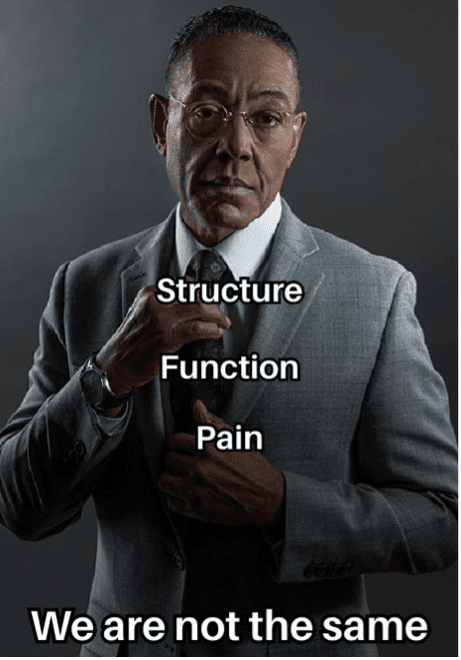We are not the same
During a recent consultation, my patient told me she couldn’t run because she had a “weak tendon.” She said her Achilles had degenerated, so she avoided running. I asked her what she meant by that, and she replied, “Well, structure equals function, right?”
(Interestingly, she didn’t have any Achilles pain.)

Structure equals function…until it doesn’t. This principle applies to human biology; however, this equation does not explain pain or account for the human body’s incredible ability to adapt. You can have good structure and poor function, just as you can have poor structure (biomedically speaking) and good function.
Why doesn’t this equation work for pain?
It is widely known that there is a poor correlation between pathology and pain. Many of the pathological changes we see on imaging are, in fact, completely normal and should not be pathologized.
Structural changes and anatomical variations do not predict pain, nor do functional movement variations. For example, you cannot look at someone running and predict they will develop knee pain, just as you cannot look at someone’s posture and assume they are in pain, or worse, suggest that they will experience pain in the future.
Put simply, you cannot see pain, therefore searching for structural anomalies does not imply causation. Many of the predictors and contributors to pain extend beyond the biomechanical model.
What happens when people with good structure and good function experience pain? Do we then search for a biomechanical variation to retrospectively link as the cause? And what if that structural variation had existed for years without issue?
Saying “structure equals function” does not capture the multifactorial nature of pain. If structure truly dictated function, then why do some people experience pain in the absence of pathology or structural abnormalities, while others have pathology without any pain? This equation is flawed and heavily embedded in the biomedical model. Understanding pathology is important, however specific pathology is linked to only 5-10% of low back pain cases (IASP, 2020). Interestingly the leading risk factors for low back pain include sedentary behaviour, smoking, obesity, and poor general health (IASP, 2022; Mahdavi et al., 2021) not specific structural pathology. This begs the question, is it really the structure that dictates the function?
Elite athletes have variations in structure and biomechanics yet perform at the top 1% of their field. Importantly, function and pain can improve without changing structure. A 10-year follow-up study of people treated for lumbar disc herniations found that symptoms could improve with or without resolution of the hernia (Fraser et al., 1995), demonstrating the disconnect between structure, function, and pain.
If correcting structure were the solution, why does pain sometimes persist after surgical interventions designed to correct it? Why does pain persist after structural healing? And why can pain resolve without any structural changes? It is easy to blame structure, but doing so can have negative downstream effects on patients’ beliefs, self-efficacy, and engagement with treatment. In an observational study on the lumbar spine, inappropriate use of MRI was associated with more back surgeries than those who didn’t have an MRI, more opioid use, greater acute care costs and worse outcomes (Jacobs et al., 2020).
Consider this…
What if structure cannot be corrected? Does that mean the person will have lifelong functional impairments? How does this influence their beliefs about recovery? This mindset may reinforce the belief that they are “stuck with this forever.” Interestingly, people who hold negative beliefs about the back are at a higher risk of developing higher intensity back pain and disability (Alyousef et al., 2018; Estee et al., 2023).
There is an abundance of evidence demonstrating that structural changes are a normal part of aging, and many of these changes are not associated with pain. Take the classic Brinjikjipaper, for example suggesting that asymptomatic degenerative changes in the spine occur in 52% of 30-year-olds increasing to 96% in 80 year old people (Brinjiki et al., 2015).
Can structural changes contribute to pain?
Yes, absolutely. But we cannot separate structure and function from the pain experience or ignore the psychological and social aspects of pain. If pain were purely linear and structure truly equalled function, then chronic pain wouldn’t exist. Surgery would always work. Placebo effects wouldn’t exist. Prognostic time frames would be easy to predict. Importantly, structure may be a contributor to pain, however treatment should be embedded in biopsychosocial approach addressing the person as a whole, and not just the structure.
If attention is constantly directed towards structure influencing function, considerations should be made to understand the potential negative implications on our patients’ beliefs and behaviours. But don’t take my word for it, let’s look at the literature on pathological findings in asymptomatic elite athletes.
A study examining the prevalence of lumbar spine degenerative changes in elite soccer players found that 92.5% had at least one spinal degenerative condition, and 50% had six or more pathological findings (Bezuglov et al., 2021). Yes, you guessed it, they were all asymptomatic. Additionally, 86.5% of elite soccer players had degenerative changes in at least one of the joints in their foot and ankle (Bezuglov et al., 2021). Furthermore, cartilaginous pathology has been identified in 97.9% of asymptomatic soccer players in both knees (Bezuglov et al., 2019).
In junior tennis players, 96% had pathological changes detected on imaging, including facet joint arthropathy, synovial cysts, disc degeneration, disc herniations, and pars interarticularis abnormalities. All were asymptomatic (Rajeswaran et al., 2014).
A four-year follow-up study of hockey players found pathological changes in 81% of athletes’ hips, including tendinopathy, muscle tears, and labral tears. Yet all were asymptomatic, and only three players developed hip and/or pelvis symptoms over the four-year period (Gallo et al., 2014). Similarly, 77% of collegiate ice hockey players demonstrated pathological abnormalities in the hip or groin with no reported symptoms(Silvis et al., 2011).
Tendon pathology is frequently observed in athletic populations. Achilles tendon pain can significantly impair performance and be challenging to treat, yet tendon pathology is highly prevalent among asymptomatic distance runners with no history of tendon pain. These findings further challenge the structure equals function narrative. Furthermore, is symptomatic people, the tendon structure does not need to change for the resolution of symptoms (de Jong et al., 2015).
Numerous studies have identified pathological changes in the shoulders of elite athletes. Extensive shoulder pathology has been documented in asymptomatic elite volleyball players (Lee et al., 2020), elite rock climbers (Cooper et al., 2022), and adolescent tennis players (Johansson et al., 2015). A recent systematic review examining anatomical abnormalities of the shoulder in asymptomatic individuals found that variations in structure are normal, with imaging abnormalities as high as 90–95%. These variations include differences in the structure and shape of the acromion and acromioclavicular joint, which are seen in both symptomatic and asymptomatic populations (Ibounig et al., 2025).
Moreover, a recent study on asymptomatic female softball pitchers identified altered bony hip morphology and asymmetries in cartilage composition (Warden et al., 2025). Perhaps these pathological changes represent normal adaptive responses to load. This is further supported by research on variations in femoral morphology and the development of primary cam-type morphology as a normal physiological response to high-level activity during skeletal development (Dijkstra et al., 2020; Dijkstra et al., 2021).
Elite athletes can perform at the highest level with optimal function and no pain despite structural changes. While pathology can certainly contribute to pain, it is clear that even in elite sports, the absence of structural variation is rare and may, in fact, be a normal and necessary adaptation.
Importantly, we should continue to ask the question, are we over pathologizing normal structural variations and should we really be pathologizing structure in the absence of symptoms?


